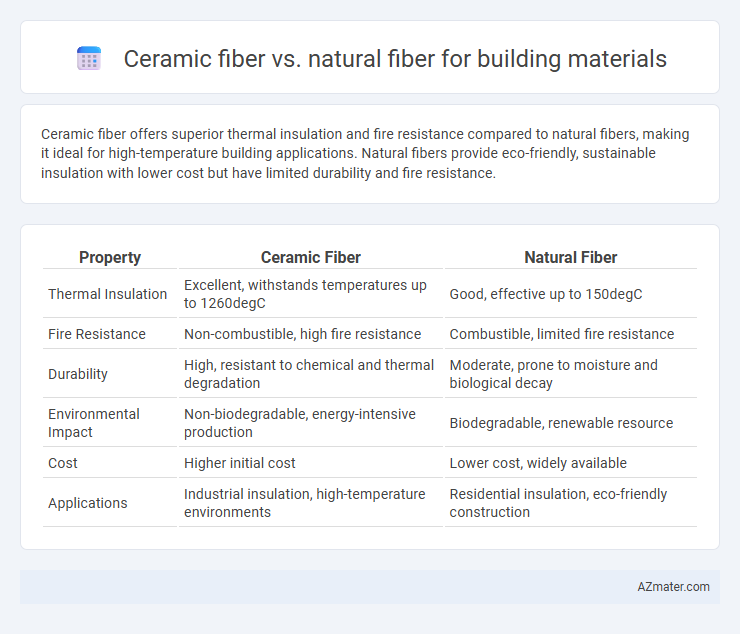Ceramic fiber offers superior thermal insulation and fire resistance compared to natural fibers, making it ideal for high-temperature building applications. Natural fibers provide eco-friendly, sustainable insulation with lower cost but have limited durability and fire resistance.
Table of Comparison
| Property | Ceramic Fiber | Natural Fiber |
|---|---|---|
| Thermal Insulation | Excellent, withstands temperatures up to 1260degC | Good, effective up to 150degC |
| Fire Resistance | Non-combustible, high fire resistance | Combustible, limited fire resistance |
| Durability | High, resistant to chemical and thermal degradation | Moderate, prone to moisture and biological decay |
| Environmental Impact | Non-biodegradable, energy-intensive production | Biodegradable, renewable resource |
| Cost | Higher initial cost | Lower cost, widely available |
| Applications | Industrial insulation, high-temperature environments | Residential insulation, eco-friendly construction |
Overview of Ceramic Fiber and Natural Fiber
Ceramic fiber offers exceptional thermal insulation and fire resistance, making it ideal for high-temperature applications in building construction, while natural fibers such as hemp, flax, and jute provide sustainable, biodegradable alternatives with good insulation properties and moisture regulation. Ceramic fiber materials are composed primarily of alumina and silica, ensuring durability and chemical stability, whereas natural fibers are plant-based and support eco-friendly building practices by reducing carbon footprints. The choice between ceramic and natural fibers depends on project requirements for thermal performance, sustainability goals, and environmental impact.
Composition and Material Properties
Ceramic fiber consists primarily of alumina and silica, offering high thermal resistance, low thermal conductivity, and excellent chemical stability, ideal for insulation in high-temperature applications. Natural fibers such as hemp, flax, or jute are composed mainly of cellulose, lignin, and hemicellulose, providing biodegradability, moisture regulation, and moderate thermal insulation with lower fire resistance. The inorganic nature of ceramic fibers ensures superior durability and fireproofing compared to organic natural fibers, which prioritize sustainability and eco-friendliness in building materials.
Thermal Insulation Performance
Ceramic fiber offers superior thermal insulation performance compared to natural fibers, with a high melting point above 1,200degC and low thermal conductivity typically around 0.03 W/m*K. Natural fibers such as cotton, hemp, or wool generally exhibit higher thermal conductivity, ranging from 0.04 to 0.06 W/m*K, which reduces their effectiveness in extreme temperature conditions. The durability and thermal shock resistance of ceramic fiber make it ideal for applications demanding consistent insulation under high heat stress, while natural fibers are better suited for moderate temperature environments with eco-friendly benefits.
Mechanical Strength and Durability
Ceramic fiber exhibits superior mechanical strength and durability compared to natural fibers, making it ideal for high-temperature insulation and fire-resistant building materials. Its resistance to thermal degradation and chemical corrosion ensures long-lasting performance in harsh environments, whereas natural fibers tend to degrade faster when exposed to moisture and UV radiation. The enhanced structural integrity and longevity of ceramic fibers significantly reduce maintenance and replacement costs in construction applications.
Fire Resistance and Safety Features
Ceramic fiber offers superior fire resistance compared to natural fibers, withstanding temperatures up to 2300degF (1260degC) without degradation, making it ideal for high-temperature insulation and fireproofing applications in buildings. Natural fibers such as cotton, hemp, or jute have lower ignition points and can combust or char at relatively low temperatures, posing higher fire hazards and limiting their use in fire-resistant construction materials. The safety features of ceramic fiber include non-combustibility and thermal stability, enhancing building fire safety codes compliance, whereas natural fibers require chemical treatments or fire retardants that may introduce health or environmental concerns.
Environmental Impact and Sustainability
Ceramic fiber insulation exhibits superior environmental durability and fire resistance compared to natural fibers, as it is non-combustible and recyclable, reducing landfill waste. Natural fibers such as hemp, cotton, or wool offer renewable and biodegradable options with lower embodied energy but may require chemical treatments for pest resistance, influencing their eco-friendliness. The choice hinges on balancing ceramic fiber's longevity and thermal efficiency against natural fiber's biodegradability and renewable sourcing for sustainable building solutions.
Cost Analysis and Availability
Ceramic fiber offers higher thermal resistance and durability but comes at a significantly higher cost compared to natural fibers like hemp or flax, which are more affordable and sustainable for construction applications. Availability of natural fibers is generally better due to their widespread agricultural production, while ceramic fibers often require specialized manufacturing and supply chains. Cost analysis favors natural fibers for budget-conscious projects, whereas ceramic fibers are preferred where high-performance insulation justifies the investment.
Ease of Installation and Handling
Ceramic fiber insulation offers superior ease of installation due to its lightweight nature and flexibility, allowing for quick cutting and fitting in tight spaces compared to natural fiber materials. Natural fibers, such as hemp or wool, often require additional moisture control and may compress during handling, leading to inconsistent insulation performance. Ceramic fibers also resist degradation from frequent handling, making them more durable and user-friendly on construction sites.
Typical Applications in Construction
Ceramic fiber is primarily used for high-temperature insulation in industrial furnaces, boilers, and fireproofing applications due to its excellent thermal resistance and durability. Natural fibers like hemp, flax, and jute are favored in sustainable building for insulation, soundproofing, and reinforcing composites, offering biodegradability and low environmental impact. Both materials contribute to energy efficiency, with ceramic fiber excelling in extreme heat environments and natural fibers supporting eco-friendly construction solutions.
Future Prospects and Innovations
Ceramic fiber offers superior thermal insulation, fire resistance, and durability, making it a leading choice for advanced building materials, especially in energy-efficient and fire-safe constructions. Innovations in nano-enhanced ceramic fibers and eco-friendly production methods are driving future prospects, positioning them as sustainable alternatives to traditional natural fibers. While natural fibers remain valued for biodegradability and cost-effectiveness, ongoing research aims to improve their strength and moisture resistance to broaden their applicability in modern green building technologies.

Infographic: Ceramic fiber vs Natural fiber for Building material
 azmater.com
azmater.com